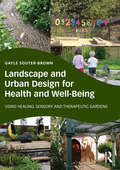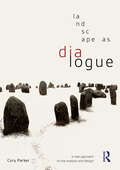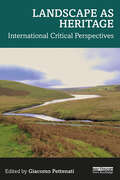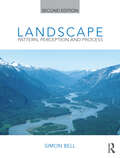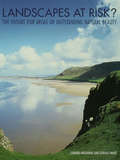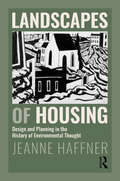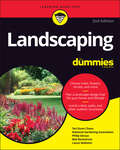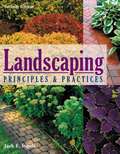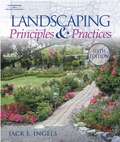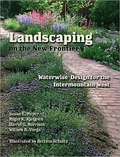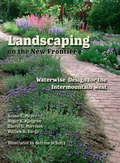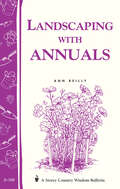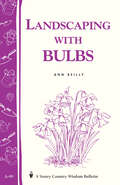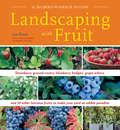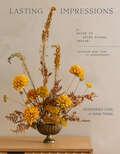- Table View
- List View
Landscape and Urban Design for Health and Well-Being: Using Healing, Sensory and Therapeutic Gardens
by Gayle Souter-BrownIn this book Gayle Souter-Brown explores the social, economic and environmental benefits of developing greenspace for health and well-being. She examines the evidence behind the positive effects of designed landscapes, and explains effective methods and approaches which can be put into practice by those seeking to reduce costs and add value through outdoor spaces. Using principles from sensory, therapeutic and healing gardens, Souter-Brown focuses on landscape’s ability to affect health, education and economic outcomes. Already valued within healthcare environments, these design guidelines for public and private spaces extend the benefits throughout our towns and cities. Covering design for school grounds to public parks, public housing to gardens for stressed executives, this richly illustrated text builds the case to justify inclusion of a designed outdoor area in project budgets. With case studies from the US, UK, Africa, Asia, Australasia and Europe, it is an international, inspirational and valuable tool for those interested in landscapes that provide real benefits to their users.
Landscape as Dialogue: A New Approach to Site Analysis and Design
by Cory ParkerLandscape as Dialogue redefines the process of understanding landscapes for students and practitioners so they can create more integrated, healthy places. Traditional site analysis sees the landscape as a series of components, evaluated individually, before being put back together. This perpetuates existing social hierarchies, maintains the need for high energy inputs and trumpets iconic designs that contribute to gentrification. This book examines the process of landscape dialogue as a natural give and take with the environment, drawing on diverse and challenging writings from design, geography, philosophy and ecological sciences to probe the relationship between humans and landscape. Each chapter begins with a discussion of a theoretical approach to landscape dialogue, such as perception, information or critique, before offering a series of practical steps and representation techniques that designers can use in understanding the landscape. Detailed illustrated case studies from around the world, including Hawaii, the American Southwest, Japan, China, Mexico, Turkey and Peru, explore the book’s lessons in practice. This must-read book offers a radical alternative to conventional analytical approaches, inspiring designers to fully engage in the landscape to ultimately generate ecologically considered places.
Landscape as Heritage: International Critical Perspectives
by Giacomo PettenatiThis edited book provides a broad collection of current critical reflections on heritage-making processes involving landscapes, positioning itself at the intersection of landscape and heritage studies. Featuring an international range of contributions from researchers, academics, activists, and professionals, the book aims to bridge the gap between research and practice and to nourish an interdisciplinary debate spanning the fields of geography, anthropology, landscape and heritage studies, planning, conservation, and ecology. It provokes critical enquiry about the challenges between heritage-making processes and global issues, such as sustainability, economic inequalities, social cohesion, and conflict, involving voices and perspectives from different regions of the world. Case studies in Italy, Portugal, Spain, Slovenia, the Netherlands, Turkey, the UK, Columbia, Brazil, New Zealand, and Afghanistan highlight different approaches, values, and models of governance. This interdisciplinary book will appeal to researchers, academics, practitioners, and every landscape citizen interested in heritage studies, cultural landscapes, conservation, geography, and planning.
Landscape as Infrastructure: A Base Primer
by Pierre BelangerAs ecology becomes the new engineering, the projection of landscape as infrastructure—the contemporary alignment of the disciplines of landscape architecture, civil engineering, and urban planning— has become pressing. Predominant challenges facing urban regions and territories today—including shifting climates, material flows, and population mobilities, are addressed and strategized here. Responding to the under-performance of master planning and over-exertion of technological systems at the end of twentieth century, this book argues for the strategic design of "infrastructural ecologies," describing a synthetic landscape of living, biophysical systems that operate as urban infrastructures to shape and direct the future of urban economies and cultures into the 21st century. Pierre Bélanger is Associate Professor of Landscape Architecture and Co-Director of the Master in Design Studies Program at Harvard University’s Graduate School of Design. As part of the Department of Landscape Architecture and the Advansed Studies Program, Bélanger teaches and coordinates graduate courses on the convergence of ecology, infrastructure and urbanism in the interrelated fields of design, planning and engineering. Dr. Bélanger is author of the 35th edition of the Pamphlet Architecture Series from Princeton Architectural Press, GOING LIVE: from States to Systems (pa35.net), co-editor with Jennifer Sigler of the 39th issue of Harvard Design Magazine, Wet Matter, and co-author of the forthcoming volume ECOLOGIES OF POWER: Mapping Military Geographies & Logistical Landscapes of the U.S. Department of Defense. As a landscape architect and urbanist, he is the recipient of the 2008 Canada Prix de Rome in Architecture and the Curator for the Canada Pavilion ad Canadian Exhibition, "EXTRACTION," at the 2016 Venice Architecture Biennale (extraction.ca).
Landscape, Well-Being and Environment
by Richard Coles Zoë MillmanWell-being is now firmly established as an overarching theme of key concern to all professionals that work, manage or design the environment. However, well-being is a complex multi-dimensional issue rooted in the ways that we encounter, perceive and interpret the environment. No single discipline can claim to have sufficient knowledge to fully explain the types of interactions that occur, therefore there is a need to draw together a wide range of professions who are exploring the consequences of their actions upon the well-being of individuals and communities. This edited work addresses the above, consisting of a collection of studies which embrace different aspects of environment, landscape and well-being to consider current approaches to well-being research and practice that fall outside the traditional concepts of well-being as part of medical research, making links with architecture, landscape design, environmental perception, social interaction and environmental sustainability. The contributors originally presented at the international conference, ‘Well-Being 2011’ jointly hosted by Birmingham City University and the Royal Institute of British Architects (RIBA); the chapters have been developed to present a coherent series of themes reviewing a wide range of literature, presenting case studies appropriate to diverse audiences.
Landscape: Pattern, Perception and Process
by Simon BellLandscapes develop and evolve through an interacting series of processes – climatic, geological, ecological and cultural – over varying periods of time. These processes shape the structure and character of the landscapes which we experience. Over time, distinctive patterns emerge – ranging in scale from the distribution of small plants to the sculptured sides of a huge canyon. Our perception of these patterns goes beyond just their visual appreciation – beautiful though they may be – into a richer understanding of how we experience our environment. By understanding this complex pattern–process interaction we can obtain a deeper awareness of landscape and our place in it – as inhabitants and as shapers. The book explores the nature of patterns and ways of classifying them before studying the nature of perception (primarily visual but including other senses), then proceeds to relate this perception to aesthetics and from there to the design process. From this point the main driving processes in landscape are introduced alongside the resulting patterns, these being climatic, landform, ecosystem and cultural aspects. It is this integrative approach of looking at landscape as a kind of self-organising system, overlaid by conscious human planning activities and the unity of pattern and process, which makes this book unique. Landscape draws from a wide range of neighbouring disciplines, of which the landscape planner or designer needs to be aware, but which are often taught as distinct elements. Bell binds these fundamentals together, which enables the landscape to be ‘read’, and this reading to be used as the basis for planning and design. This second edition updates and refreshes the original material with added sections and new photos, particularly making use of the developments in satellite photography. Featuring full colour throughout, this textbook is ideal for anyone studying landscape architecture or any of the disciplines which intersect with the landscape, and which affect it.
Landscapes at Risk?: The Future for Areas of Outstanding Natural Beauty in England and Wales
by Edward Holdaway Gerald SmartAreas of Outstanding Natural Beauty (AONBs) together with National Parks are the highest quality landscapes in England and Wales, and have been designated to conserve that quality. AONBs have always been regarded as 'second' to national parks in terms of the legislation and resources provided by the nation to look after them. At the turn of the century they are at a cross-roads - there are many challenges to be overcome if they are to survive as the best. This book examines whether they are fit to meet the challenges and sets out a bold new Agenda for their survival.Landscapes at Risk? covers the history and development of AONBs in England and Wales set in the context of protected landscapes generally in the UK. It focuses on the evolution of policies towards them, the arrangements for their administration, conservation and management, the land management and planning context within which they have evolved, and the adequacy of the proposals that have been put forward for their long-term well-being. Throughout the analysis there are numerous references to the many initiatives that have been and are being taken by AONB managers and others to secure their future. The book features a series of case studies of individual AONBs to illustrate the main points being made in the text.
Landscapes of Housing: Design and Planning in the History of Environmental Thought
by Jeanne HaffnerIn the twenty-first century, housing has become a site of ecological experimentation and environmental remediation. From the vantage point of contemporary architecture, conservation concerns and emergent building science technologies support one another, with new processes and materials deployed to reduce energy usage, water consumption, and carbon dioxide emissions. Landscapes of Housing examines this trend in historical perspective, arguing for a more considered environmental vision that includes the organic, social, and cultural dimensions of landscape. By shifting the focus from architecture, the book highlights and critiques the relationship between dwelling and landscape itself. Contributors from a wide range of international perspectives propose a more integrative ecology that includes history, culture, society, and materiality, in addition to technology, within contemporary ecological housing programs. This book will be a resource for upper-level students, academics, and researchers in landscape architecture interested in the social and political implications of ecological housing.
Landscaping Earth Ponds
by Tim MatsonThe guru of earth ponds explains how to site, design, shape, and plant these beloved fixtures of rural landscapes-and make them fit your property and your life. In the decades since he wrote his acclaimed "Earth Ponds," Tim Matson has designed scores of ponds, each unique to its site and its owners. In "Landscaping Earth Ponds," he shares what he has learned to make these captivating ponds truly fit into their landscapes and into the lives and lifestyles of their owners. Ponds have long been valued for their charm and utility: how else can you simultaneously enliven your landscape, create recreational opportunities, help the environment, and increase your property value? Earth ponds are increasingly recognized for the full range of gardening, landscaping, and ecological promise they hold. As pond-building methods have been perfected, more homeowners are restoring existing ponds or digging new ones. With dozens of color photographs, Matson shows you how to site a pond in right relation to your house, offering surprisingly simple ways to visually link the two. His proven methods and designs reflect the many moods water evokes. Screen your pond for privacy, create a sandy beach and natural diving platform, encourage wetland gardens, line the shores with moisture-loving perennials, or design your gardens and paths to create a sense of mystery and adventure.
Landscaping For Dummies
by National Gardening Association Bob Beckstrom Lance Walheim Teri Dunn Chace Philip GirouxCreate an eye-catching outdoor oasis with this no-nonsense guide to landscaping As families spend more time at home, they're expanding their living space to their yards, decks, and patios. When you're ready to upgrade the look of your landscape, Landscaping For Dummies offers advice on installing fences and walkways, choosing hardy plants and trees, and enhancing natural habitats for the critters and creatures lurking in your neighborhood. You'll find out how to make your backyard a relaxing retreat space and discover the enjoyment and satisfaction that comes from working in your yard. Landscaping For Dummies includes: Lists of recommended plants and varieties, including the best ones for privacy plantings, low-maintenance groundcovers, and small gardens Advice on how to deal with special landscaping concerns, including fire-prone areas, bee and butterfly gardens, and drought-tolerant and native landscapes Instructions on installing permanent features like decks, patios, fences, and more Pointers on how to water more efficiently, including the latest tools and technologies that can save you time With a little bit of planning and some digging, trimming, or planting, you'll be set to enjoy your yard whenever the mood strikes. Let Landscaping For Dummies be your guide to making the most of your outdoor space.
Landscaping Principles & Practices
by Jack E. IngelsLandscaping: Principles & Pratices, 7th Edition provides the basic knowledge and industry information needed to be successful in the field of landscape design and architecture. Focusing on three areas of professional practice; design, contracting and management, traditional topics such as design, plant installation, and pricing are covered, as well as topics not found in most other books, such as interior landscaping, xeriscaping, water gardens, and safety.
Landscaping Principles And Practices (6th Edition)
by Jack E. IngelsNewly reorganized and updated, the fifth edition of this popular text offers a comprehensive introduction to landscape management. To present a balanced view of the industry as a process, the text is now organized by the industry's three career areas - design, contracting, and maintenance - to illustrate the interdependence of these areas. New material covers such current topics as xeriscaping and landscape calculations, providing students with the latest in landscaping techniques and management. Excellent for launching students into landscaping careers!
Landscaping for Privacy: Innovative Ways to Turn Your Outdoor Space into a Peaceful Retreat
by Marty WingateThe area around your home is your haven, your sanctuary, your refuge from the noise and irritation of traffic, eyesores, and nosy neighbors. Or at least it could be if there was some sort of barrier between your front yard and the sidewalk, or if you didn't have to stare at the back of the neighbors' garage when you want to relax on your patio. Landscaping for Privacy brims with creative ideas for minimizing or even eliminating the nuisances that intrude on your personal outdoor space. Scores of real-world examples show you how to keep the outside world at bay by strategically placing buffers (such as berms or groups of small trees), barriers (such as fences), and screens (arbors or hedges, for example) around your property. And the helpful plant lists tell you precisely which varieties to choose in order to enhance your sense of seclusion. If you've ever felt frustrated by the lack of privacy whenever you step outside your home, this inspiring book will steer you toward an achievable solution.
Landscaping on the New Frontier
by Susan E. Meyer Roger K. Kjelgren Darrel G. Morrison William A. VargaA practical volume for the home or business owner on landscaping with native, drought-tolerant plants in the Rocky Mountain West. Filled with color illustrations, photos, and design sketches, over 100 native species are described, while practical tips on landscape design, water-wise irrigation, and keeping down the weeds are provided. In this book you will learn how to use natural landscapes to inspire your own designed landscape around your business or home and yard. Included are design principles, practical ideas, and strong examples of what some homeowners have already done to convert traditional "bluegrass" landscapes into ones that are more expressive of theWest. Landscaping on the new Frontier also offers an approach to irrigation that minimizes the use of supplemental water yet ensures the survival of plants during unusually dry periods. You will learn how to combine ecological principles with design principles to create beautiful home landscapes that require only minimal resources to maintain.
Landscaping on the New Frontier: Waterwise Design for the Intermountain West
by Susan E. Meyer Roger K. Kjelgren Darrel G. Morrison William A. Varga Bettina SchultzA practical volume for the home or business owner on landscaping with native, drought-tolerant plants in the Rocky Mountain West. Filled with color illustrations, photos, and design sketches, over 100 native species are described, while practical tips on landscape design, water-wise irrigation, and keeping down the weeds are provided. In this book you will learn how to use natural landscapes to inspire your own designed landscape around your business or home and yard. Included are design principles, practical ideas, and strong examples of what some homeowners have already done to convert traditional "bluegrass" landscapes into ones that are more expressive of theWest. Landscaping on the new Frontier also offers an approach to irrigation that minimizes the use of supplemental water yet ensures the survival of plants during unusually dry periods. You will learn how to combine ecological principles with design principles to create beautiful home landscapes that require only minimal resources to maintain.
Landscaping with Annuals: Storey's Country Wisdom Bulletin A-108
by Ann ReillySince 1973, Storey's Country Wisdom Bulletins have offered practical, hands-on instructions designed to help readers master dozens of country living skills quickly and easily. There are now more than 170 titles in this series, and their remarkable popularity reflects the common desire of country and city dwellers alike to cultivate personal independence in everyday life.
Landscaping with Bulbs: Storey's Country Wisdom Bulletin A-99 (Storey Country Wisdom Bulletin Ser.)
by Ann ReillySince the 1973 publication of Storey's first Country Wisdom Bulletin, our commitment to preserving the arts, crafts, and skills of country life has never wavered. We now have more than 200 titles in this series of 32-page publications, and their remarkable popularity reflects the common desire of country and city dwellers alike to cultivate personal independence in everyday life.
Landscaping with Fruit: Strawberry ground covers, blueberry hedges, grape arbors, and 39 other luscious fruits to make your yard an edible paradise.
by Lee A. ReichDiscover the joy of homegrown apples, fresh-picked cherries, and dozens of other fruits with this definitive guide to creating a more delicious backyard! Lee Reich shows you how to grow temperate-zone fruit at home, from site analysis and climate assessment through plant selection, pest control, pruning, and harvesting. A plant-by-plant guide recommends 39 palate-pleasing species that are especially well-suited to the home landscape. Add beauty to your outdoor space while bringing organic fruit to your table. This publication conforms to the EPUB Accessibility specification at WCAG 2.0 Level AA.
Landscaping with Native Plants of Minnesota
by Lynn M. SteinerAn updated guide to Minnesota’s hardy native plants and how to incorporate them into your home landscape—with profiles of flowers, trees, shrubs, and more.Gardeners enjoy Minnesota’s native plants for more than their beauty. They are low maintenance, can survive difficult soil and weather conditions, provide unique landscape options, and celebrate the state’s natural heritage. In this second photo-filled edition of Landscaping with Native Plants of Minnesota, you’ll learn how to identify native plants, keep them healthy and thriving in the state’s harsh climate, and design and install an attractive home landscape perfect for your lifestyle. Also included in this new edition are comprehensive plant profiles and gardening essentials for approximately 350 native flowers, trees, shrubs, vines, evergreens, grasses, and ferns that grew in Minnesota before European settlement, as well as complete information on planting, maintenance, and landscape uses for each plant.
Landscaping: Principles and Practices (7th edition)
by Jack IngelsLandscaping: Principles & Practices, 7th Edition provides the basic knowledge and industry information needed to be successful in the field of landscape design and architecture. Focusing on three areas of professional practice; design, contracting and management, traditional topics such as design, plant installation, and pricing are covered, as well as topics not found in most other books, such as interior landscaping, xeriscaping, water gardens, and safety.
Landschaft und Gefühl – eine neopragmatistische Redeskription auf Grundlage der Philosophie Fichtes: Ein Beitrag zur humanistischen Geographie (RaumFragen: Stadt – Region – Landschaft)
by Olaf Kühne Karsten Berr Petra LohmannDie Befassung mit ‚Landschaft‘ hat in den letzten Jahren in der Öffentlichkeit und den Wissenschaften an Bedeutung gewonnen. In Philosophie, Humangeographie und Sozialwissenschaften haben sich unterschiedliche Traditionen im Umgang mit ‚Landschaft‘ entwickelt. Diese werden in dem vorliegenden Buch hinsichtlich ihrer Tauglichkeit für einen Beitrag zur Analyse und Regelung von Landschaftskonflikten und daraufhin untersucht, Antworten auf die landschaftsbezogenen Herausforderungen der Gegenwart sowohl in Bezug auf Wissenschaft als auch Gesellschaft zu leisten. Zentraler Ansatzpunkt ist die Erörterung des Selbstverhältnisses des Individuums im Konflikt, die im Rückgriff auf Fichtes Theorie des Gefühls im Rahmen einer Philosophie des Subjekts erfolgt. Mit dieser Theorie soll insbesondere die Einseitigkeit wissenschaftlicher Zugänge zum Individuum angegangen werden, die einerseits in der überproportionalen Betonung der Ratio und andererseits in der fehlenden Verortung des Gefühls zuallererst im Individuum selbst besteht. Die mangelnde Beachtung der Binnenperspektive des Individuums im Konflikt führt zu einer Bedeutungsferne des Konflikts für das Individuum sowie infolgedessen zur Verunklarung der konfliktären Situation und damit letztlich Unfähigkeit sinnvollen Handelns bezogen auf die Regelung eines solchen Konflikts. Mit diesem Zugang erweitern wir den sich aktuell in Entwicklung befindlichen neopragmatistischen Ansatz der Landschaftsforschung und stellen die Bedeutung eines humanistischen Ansatzes zu Landschaft heraus, der den Menschen als fühlendes und sittliches Wesen in das Zentrum der Überlegungen stellt. Damit leistet das Buch einen Beitrag zur Redeskription der humanistischen Geographie.
Lasting Impressions: A Guide to Dried Floral Design Featuring More Than 50 Arrangements
by Tennessee JaneA step-by-step guide to the hottest trend in floral design: learn to create modern, everlasting arrangements with dried florals and other materials. A far cry from the old shabby chic wreaths and bouquets, contemporary dried floral designs are often minimalist and striking. At the forefront of this movement is Saint Maide&’s Tennessee Jane, whose work Goop calls &“stunningly unique.&” In this book, she offers expert instruction and easy-to-follow guides for more than fifty attractive, attainable, and affordable arrangements of every size and style. Each chapter is designed to evoke a mood. In Calm, the natural texture and color of dried materials like grasses are put to beautiful use in spare, sculptural arrangements. In Bold, readers will experiment with funky forms and vibrant spray-painted pieces to create eye-catching installations. And in Festive, they&’ll celebrate the holiday season with a cranberry-red tabletop arrangement, greenery-covered candlesticks, and a Spanish moss mini tree. Readers can re-create these projects using pre-dried material (readily available online and at local florists and craft stores) or dry their own fresh florals, using the simple methods outlined in the front of the book. With hundreds of beautiful photographs and detailed DIY instruction, this book is at once a primer on contemporary dried floral design and an inspiration for readers to create their own exceptional arrangements.
Lasting Value: Open Space Planning and Preservation Successes
by Rick PruetzAmericans are committing 'country-cide', says Rick Pruetz, FAICP, converting farms into suburban yards and channeling streams that once provided flood control, water purification, habitats, and recreational opportunities. But rather than rail against overdevelopment, this book celebrates communities succeeding in preservation. For ten years Pruetz explored communities that excel in saving their natural environment. In twenty-four illustrated vignettes, he captures the character of places from the volcanic range near downtown Albuquerque, New Mexico, to Minneapolis’s Grand Rounds park system, to farmland improbably preserved on Long Island. As the longtime city planner of Burbank, California, Pruetz offers more than an appreciation of these communities. He brings a planner’s-eye view of the practices behind their achievements. His detailed reports of creative preservation solutions mark the trail for planners, commissioners, and citizens who seek to preserve the green legacy in their own backyards.
Latin America: Writings on Architecture, Landscape, and the Environment, 1876-1925
by Jacques LambertThis title is part of UC Press's Voices Revived program, which commemorates University of California Press’s mission to seek out and cultivate the brightest minds and give them voice, reach, and impact. Drawing on a backlist dating to 1893, Voices Revived makes high-quality, peer-reviewed scholarship accessible once again using print-on-demand technology. This title was originally published in 1967.
Latin American Modern Architectures: Ambiguous Territories
by Patricio Del Real Helen GygerLatin American Modern Architectures: Ambiguous Territories has thirteen new essays from a range of distinguished architectural historians to help you understand the region’s rich and varied architecture. It will also introduce you to major projects that have not been written about in English. A foreword by historian Kenneth Frampton sets the stage for essays on well-known architects, such as Lucio Costa and Félix Candela, which will show you unfamiliar aspects of their work, and for essays on the work of little-known figures, such as Uruguayan architect Carlos Gómez Gavazzo and Peruvian architect and politician Fernando Belaúnde Terry. Covering urban and territorial histories from the nineteenth and twentieth centuries, along with detailed building analyses, this book is your best source for historical and critical essays on a sampling of Latin America's diverse architecture, providing much-needed information on key case studies. Contributors include Noemí Adagio, Pedro Ignacio Alonso, Luis Castañeda, Viviana d’Auria, George F. Flaherty, María González Pendás, Cristina López Uribe, Hugo Mondragón López, Jorge Nudelman Blejwas, Hugo Palmarola Sagredo, Gaia Piccarolo, Claudia Shmidt, Daniel Talesnik, and Paulo Tavares.
